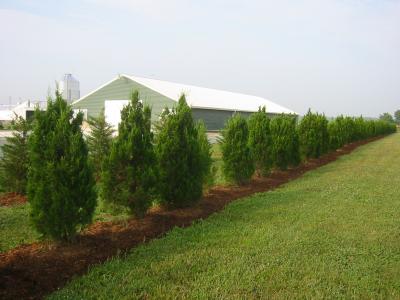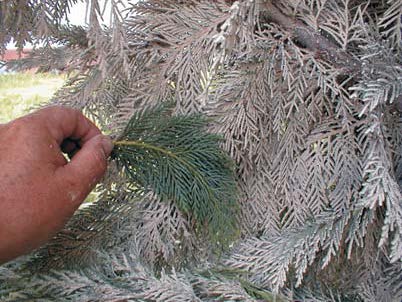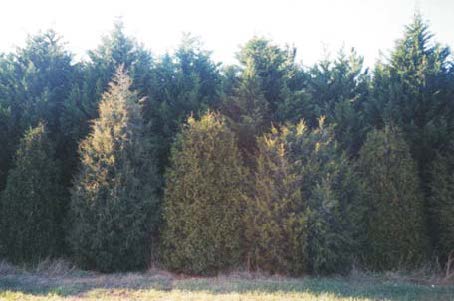The continuing urbanization of rural America combined with environmental regulation requires poultry producers to develop new approaches for meeting both increasing nuisance complaints and regulatory requirements. Strategically planting trees around poultry houses is a sound, practical, efficient, and cost-effective technology for addressing both issues. Once thought to interfere with natural ventilation during the summer, such plantings have become both feasible and desirable as poultry housing shifts to tunnel, black-out, and windowless-type systems. Planting trees around poultry farms as a visual screen, a vegetative filter, and a windbreak offers the poultry producer several potential advantages.

Fosters Good Neighbor Relations
Trees filter odor, dust, feathers, and noise emitted by poultry operations. Trees can be highly effective in scrubbing odor-laden dust particles from exhaust fans. Wind tunnel modeling of a three-row shelterbelt found reductions of 35 to 56 percent in the downwind transport of dust (which carries odors) and aerosols. One study (Hartung, 1985) has suggested that filtering the dust from exhaust air could reduce odors from animal facilities up to 65 percent. Trees can also absorb and diffuse noises, reducing sound levels by half.

Trees visually screen poultry houses and routine farm activities. Given time, the trees will shield all aspects of a poultry operation, from deliveries to litter cleanout.
Trees create an aesthetically pleasing landscape that increases property values. The landscaped appearance that develops with maturing trees can increase property values for both the poultry farm and adjoining neighbors by 5 to 20 percent. This visual screen blocks negative images of poultry operations; for example, a recent survey of neighbors near swine operations in Pennsylvania found that “attractive” farms were perceived as having less odor (Mikesell et al. 2001).
Demonstrates Proactive Environmental Stewardship
A well-designed tree planting may help reduce ammonia emissions. Trees physically capture both ammonia gas and ammonia-laden dust particles. A tree program can be an early strategy in dealing with the emissions issue in coming years.
Trees play an important role in reducing greenhouse gas. Trees capture carbon dioxide, storing the carbon in the wood (carbon sequestration) and releasing oxygen back into the air.
Trees absorb and filter nutrients that might escape from the farm. Tree roots absorb nutrients and the tree helps filter nutrients from runoff. Root absorption and reduction in overland flow can prevent more than 80 percent of nitrogen and phosphorus from entering adjacent water bodies.
May Improve Production Efficiency
Properly established windbreaks can save energy costs. Previous research for other applications suggests that this natural system can reduce heating costs by 10 to 40 percent; cooling costs by 20 percent. Shading the area around houses can reduce the ground temperature by 20°F. Preliminary data suggest that summer air temperatures next to poultry houses shaded by woods on the western exposure may be up to 7°F cooler in the afternoon than air around houses in an open area.
Trees protect poultry houses from weather damage. Trees may minimize structural damage by protecting houses from wind. Properly designed windbreaks can also serve as a living snow fence. A tree windbreak can capture up to 12 times more snow per foot of height than a picket fence, at 10 percent of the cost.


Trees may improve biosecurity. By filtering airborne particulates, trees may block the transfer of airborne diseases (such as Salmonella enteriditis and larynogtracheitis) both to and from a poultry farm.
The Down Side
Although a designed tree planting offers significant advantages to a poultry farm, the producer should consider its negative aspects:
- Some land, though limited, will be taken out of production;
- Trees cost, as does labor for planting and maintenance;
- May restrict the view of the houses;
- May limit access to some roadways; and
- A health risk may develop if the trees become habitat for wild birds.
Actually, disease has not yet been associated with tree plantings — in fact, one researcher (Villafane et al. 2001) found that trees reduced rodent populations on poultry farms, concluding that trees may provide perches for raptors that feed on the rodents.
Developing a Designed Tree Program
Strategic planting of multiple rows of trees or shrubs around the perimeter of a poultry farm must be specifically designed for that farm and for each individual side of the farm. Focusing on the program’s three major objectives – creating a visual screen, a vegetative filter, and windbreak/shade – the plan must take into account the house ventilation type, fan location, house orientation, proximity to neighbors, and the entire farm layout. The Natural Resources Conservation Service, Cooperative Extension Service, and Soil Conservation Districts offer technical and cost-share assistance in developing plans to meet these criteria. Growers should also consult with their poultry companies to establish how close trees should be to houses, taking into account the trees’ spread at maturity and location of service roads and loadout areas.
Suggestions for tunnel-ventilated houses:
- Multiple rows of dense evergreens should be planted around the farm perimeter;
- Additional rows of dense evergreen or deciduous trees on the tunnel fan end of the house will maximize filtering during the summer.
- For maximum emissions-scrubbing, tree lines should be as close to tunnel exhaust fans as possible. But, to not interfere with fan efficiency, trees should be no closer than a distance five times the diameter of the fans.
- Tall evergreens or deciduous trees on the inlet end of house will provide a cooling effect in the summer.
Suggestions for conventional ventilated houses:
- On the prevailing wintertime wind side of the farm, multiple rows of dense evergreens should be used.
- On the summertime prevailing wind side, tall evergreens and/or deciduous trees without lower limbs will provide a partial visual screen and shade while minimizing air blockage.
- For houses with a western sidewall exposure, tall, wind-tolerant deciduous trees will provide maximum shade.
- The windward side of the windbreak should have evergreens that retain their lower branches close to the ground; otherwise, evergreen shrubs may have to be planted to compensate for the openings.
- Plantings on the ends of houses will also require adequate distance to accommodate loadouts.
A tree line to screen manure sheds and dead-bird composters is vital.
- Tunnel-ventilated farms may require two sets of tree lines, one near the tunnel fans and another to screen the manure and composter facilities.
Essential to the tree plan is planting the right tree at the right place for the right purpose.
Desirable features of trees for poultry farms:
- maximum vegetative density with complex leaf shapes;
- waxy or hairy leaves to promote filtering ability;
- tap or deep roots;
- wind tolerance;
- low maintenance and care;
- medium to fast growth; and
- tolerance to nutrients found around houses.
Avoid trees and shrubs that attract wild birds and/or have wide crowns that obstruct traffic. And do not plant invasive species.
Other considerations:
- property lines
- dwellings
- traffic visibility
- surface and subsurface drainage rights-of-ways
- overhead and below-ground wires
- weed management as the trees become established
References
Hartung, J. 1985. Dust in livestock buildings as a carrier of odors. Pages 321-32 in Odor Prevention and Control of Organic Sludge and Livestock Farming. Elsevier Applied Science Publishers, New York.
Malone, G.W. and D. Abbott-Donnelly. 2001. The Benefits of Planting Trees Around Poultry Farms. Bulletin No.159. University of Delaware, Georgetown.
Mikesell, R.C., K.B. Kephart, L.J. Ressler, and F.K. Willitis. 2001. Comparison of neighbor and non-neighbor perceptions of large-scale animal agriculture. International Symposium on Animal Production and Environmental Issues. Oct. 3-5, Research Triangle Park, NC.